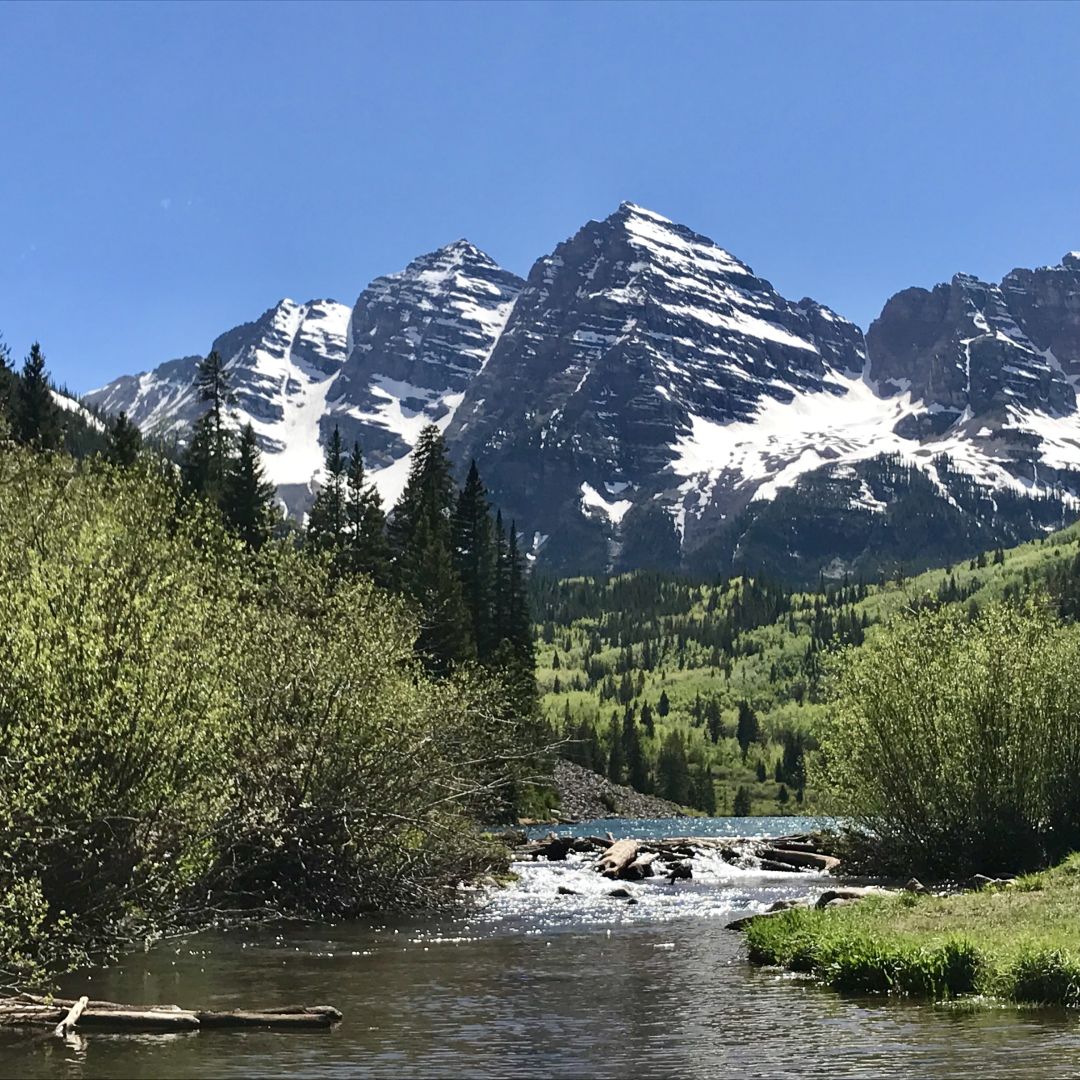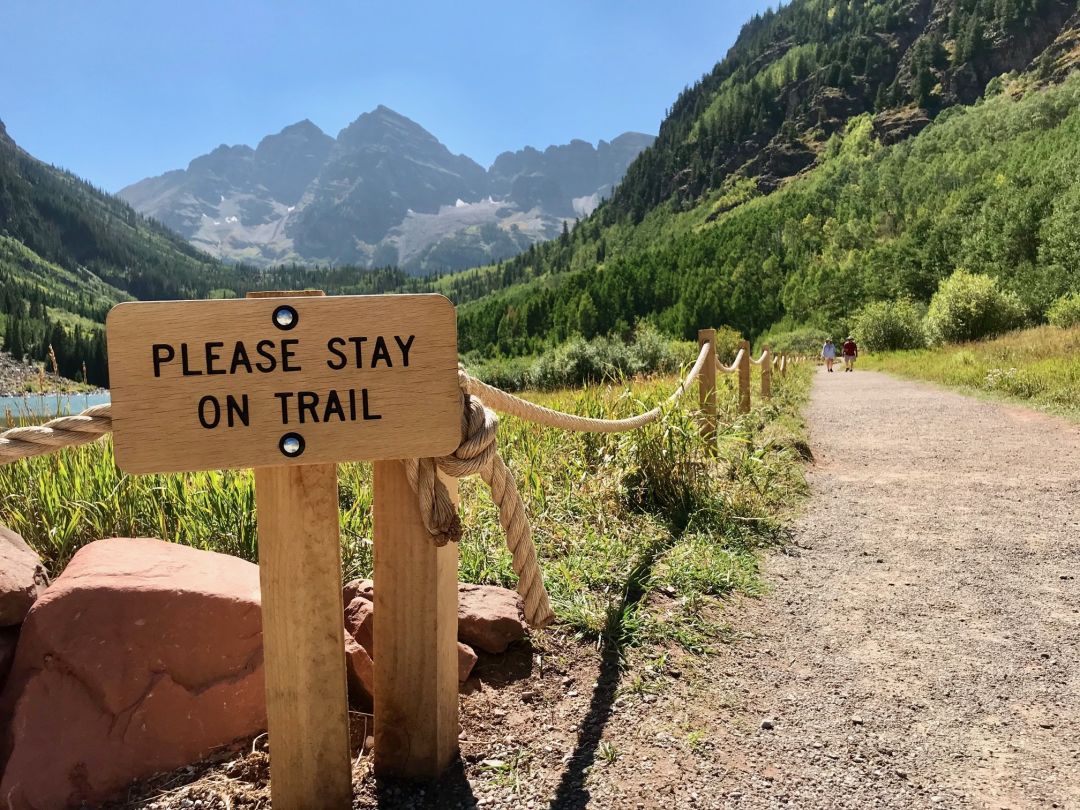11 Ways to Do the Maroon Bells

Image: Allison Pattillo
Every season is a great one to visit the Maroon Bells–Snowmass Wilderness area (aka the Maroon Bells, or just the Bells); but summer and autumn tend to be the most popular, as road access makes it easier to get to the incredible views. (In the winter, the road is plowed only up until the T-Lazy-7 Ranch.) The area's sheer beauty also makes it busy—after all, these are the most photographed peaks in the US. Thankfully, with a little planning and possibly some sweat effort, you can customize a Maroon Bells experience to suit your effort level.
After October 6, driving yourself to the Bells during the day is an option—until it isn't, as the parking lot fills up quickly, which is why we aren't including it on this list. Instead, consider one of these more creative exploration modes.
Ride the bus
Don't roll your eyes—it's actually entertaining. This is the 41st summer season that the Roaring Fork Transportation Authority (RFTA) has provided bus service to the Bells to ease congestion and reduce pollution. And it's worked wonders. Perhaps knowing that many of us would have preferred to drive ourselves, the bus drivers make the ride worth your while by sharing interesting historical and geographical facts as well as handy information; they might even point out a moose or two for you along the way. And you can bring your leashed dog on the bus.
Read More Here: A Q&A With Roaring Fork Transportation Authority's John Pennington
Hop on the free Castle Maroon bus in town that takes you to Aspen Highlands, then pick up the Bells bus from there. (Parking your own car at Highlands costs $10–$25). The new Maroon Bells Basecamp, inside Four Mountain Sports and the lodge at the base of Highlands, provides a place to hang out before or after bus rides and offers interactive displays about the famous peaks and their surroundings. Snacks and drinks are for sale, too.
Bus service runs daily through October 6, with the first bus leaving Highlands at 8:05 a.m. and the last bus returning from the Bells at 5 p.m. Tickets: $8 for adults, $6 for children 6 to 16 and seniors 65 and older. Children 5 and younger ride for free. Purchase tickets at Rubey Park Transit Center in Aspen or at Four Mountain Sports at Aspen Highlands. Another option: Aspen Snowmass's $37 sightseeing ticket includes a Maroon Bells ticket, as well as gondola/chairlift rides, food credits, and bike rental discounts (but not e-bikes). rfta.com
Ride your bike/Rent an e-bike
Yes, all the way to Maroon Lake. It's a grind—with about 1,600 feet of climbing over about 22 roundtrip miles of riding (Aspen to the Bells and back)—but a satisfying one. The lack of car traffic when the buses are running up Maroon Creek Road makes for a less stressful ride.
Prefer to ease into the ride rather than tackle the whole thing? Bring your bike on the bus for the trip up (you'll need to cycle to Highlands, though, as the bus from Aspen doesn't permit bikes), then pedal and coast your way back into town. Or rent an e-bike for an assist on the uphill; it may feel a bit like cheating, but you'll be able to zip up to the Bells in no time. Remember to follow the rules of the road, hydrate, and and wear a helmet. There are restrooms, water fountains, and a seasonal information station at Maroon Lake; bring your own snacks. Four Mountain Sports rents e-bikes at the base of Aspen Highlands for $85 for a half-day, which is plenty of time to ride to and from the Bells.
Horseback ride
Enjoy the views of Maroon Creek Valley, avoid the crowds, and stay off the standard trails by booking a horseback riding trip with Maroon Bells Guide and Outfitters (which leases the T-Lazy-7 Stables for the summer season). Trip options include an hour ride, half-day ride with lunch, and even an overnight ride. Reservations are required, and prices vary based upon the trip you choose.
Read More Here: Equine Etiquette 101: Top Tips for the Trails

Fencing along the lake is a recent addition to the Maroon Bells. While it's had mixed reviews, the fencing wasn't added to make it more challenging for you to get the ultimate photo—it was added to protect the fragile ecosystem around Maroon Lake. Please stay on the trail.
Image: Allison Pattillo
Go for a hike
Once you make it to Maroon Lake, it's time to lace up your favorite hiking or trail running shoes and start exploring. You can hike the easy Scenic Loop, make your way towards Crater Lake for more of a challenge, meander along Maroon Creek Trail (the bus will pick you up at the East Maroon Portal), or use the area as a launching pad to hike the Four Pass Loop or hike over to Crested Butte. Pick up a map at the information center at Maroon Lake for the first three options; the latter two require lots of advance preparation.
Read More Here: Hike From Aspen to Crested Butte
Camp
The most reasonable "room" you can book in town is one of the campsites at the Bells. Not only are they a good value, they offer incredible views too. Options for developed campgrounds in the Maroon Bells Scenic Area are Silver Bar (4 sites), Silver Bell (14 sites), and Silver Queen (5 sites). Reserve your piece of paradise by calling 877-444-6777.
Run/Roller ski
This isn't a recommendation so much as a warning: yes, you may see people roller skiing up to Maroon Lake (which seems more sane than roller skiing down). You may even spot the occasional runner making his or her way up and down the road. Chances are likely that 1) he or she lives here and is used to the elevation and 2) he or she is training for the next gnarly mountain race or adventure expedition. Simply offer a knowing nod or wave as you pass by.
Ski/Snowshoe/Fat bike
Even though the road to the Bells is closed to vehicular traffic during the winter and early spring, you can still hoof it. T-Lazy-7 Ranch offers snowmobile tours up to the lake and also grooms the road, making it easily navigable for those on Nordic skis, snowshoes, and fat bikes. It's hard work, but being up there in the winter is a surreal experience.
Climb
The Bells themselves consist of two 14ers (i.e., a mountain that's at least 14,000 feet in elevation): Maroon Peak and North Maroon Peak. A third, Pyramid Peak, lies on the other side of the valley. If you're interested in climbing them, read our guide to area 14ers and reach out to the Elk Mountain Safety Coalition for information, education, and preparation assistance.
Read More Here: A New Program Educates Climbers About Elk Mountain 14ers
Note: This article was updated July 10, 2019













































